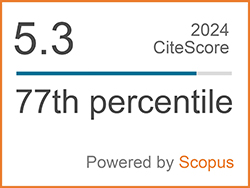High Strength Bio-Foams of Cassava Starch/Wheat Gluten Blends by Microwave Processing
Abstract
Keywords
[1] M. M. Hassan, M. J. Le Guen, N. Tucker, and K. Parker, “Thermo-mechanical, morphological and water absorption properties of thermoplastic starch/cellulose composite foams reinforced with PLA,” Cellulose, vol. 26, pp. 4463–4478, 2019, doi: 10.1007/s10570-019-02429-5.
[2] C. M. Machado, P. Benelli, and I. C. Tessaro, “Study of interactions between cassava starch and peanut skin on biodegradable foams,” International Journal of Biological Macromolecules, vol. 147, pp. 1343–1353, 2020, doi: 10.1016/j.ijbiomac.2019.10.169.
[3] D. R. Tapia-Blácido, G. J. Aguilar, M. T. de Andrade, M. F. Rodrigues-Júnior, and F. C. Guareschi-Martins, “Trends and challenges of starch-based foams for use as food packaging and food container,” Trends in Food Science and Technology, vol. 119, pp. 257–271, 2022, doi: 10.1016/j.tifs.2021.11.010.
[4] T. C. Sunarti, H. Integrani, and K. Syamsu, “Effect of cocopeat addition to some properties of cassava starch‐based foam,” Macromolecular Symposia, vol. 353, no. 1, pp. 133–138, 2015, doi: 10.1002/masy.201550318.
[5] W. Sanhawong, P. Banhalee, S. Boonsang, and S. Kaewpirom, “Effect of concentrated natural rubber latex on the properties and degradation behavior of cotton-fiber-reinforced cassava starch biofoam,” Industrial Crops and Products, vol. 108, pp. 756–766, 2017, doi: 10.1016/j.indcrop.2017.07.022.
[6] X. Zhang, Z. Teng, R. Huang, and J. M. Catchmark, “Biodegradable starch/chitosan foam via microwave assisted preparation: Morphology and performance properties,” Polymers, vol. 12, no. 11, p. 2612, 2020, doi: 10.3390/polym12112612.
[7] D. K. Matsuda, A. E. Verceheze, G. M. Carvalho, F. Yamashita, and S. Mali, “Baked foams of cassava starch and organically modified nanoclays,” Industrial Crops and Products, vol. 44, pp. 705–711, 2013, doi: 10.1016/j.indcrop. 2012.08.032.
[8] X. Wang et al., “Starting materials, processes and characteristics of bio-based foams: A review,” Journal of Bioresources and Bioproducts, vol. 9, pp.160–173, 2024, doi: 10.1016/j.jobab.2024.01.004.
[9] J. C. Bénézet, A. Stanojlovic-Davidovic, A. Bergeret, L. Ferry, and A. Crespy, “Mechanical and physical properties of expanded starch, reinforced by natural fibres,” Industrial Crops and Products, vol. 37, no. 1, pp. 435–440, 2012, doi: 10.1016/j.indcrop.2011.07.001.
[10] B. F. Bergel, L. L. Araujo, and R. M. C. Santana, “Effects of the addition of cotton fibers and cotton microfibers on the structure and mechanical properties of starch foams made from potato starch,” Carbohydrate Polymers: Technological and Applications, vol. 2, p. 100167, 2021, doi: 10.1016/j.carpta.2021.100167.
[11] A. Namphonsane et al., “Development of biodegradable rigid foams from pineapple field waste,” Polymers, vol. 15, no. 13, p. 2895, 2023, doi: 10.3390/polym15132895.
[12] L. Deng, H. He, Z. Chen, S. Liu, and V. S. Chevali, “Effects of wood fiber size on the performance of biodegradable foam,” Journal of Biobased Materials and Bioenergy, vol. 11, no. 3, pp. 206–209, 2017, doi: 10.1166/jbmb.2017.1662.
[13] C. Chiarathanakrit, S. A. Riyajan, and K. Kaewtatip, “Transforming fish scale waste into an efficient filler for starch foam,” Carbohydrate Polymers, vol. 188, pp. 48–53, 2018, doi: 10.1016/j.carbpol.2018.01.101.
[14] N. Kaisangsri, O. Kerdchoechuen, and N. Laohakunjit, “Characterization of cassava starch based foam blended with plant proteins, kraft fiber, and palm oil,” Carbohydrate Polymers, vol. 110, pp. 70–77, 2014, doi: 10.1016/ j.carbpol.2014.03.067.
[15] J. Xu and Y. Li, “Wheat gluten–based coatings and films: Preparation, properties, and applications,” Journal of Food Science, vol. 88, no. 2, pp. 582–594, 2023, doi: 10.1111/1750-3841.16454.
[16] C. G. Barreras-Urbina et al., “Simple method to obtaining a prolonged-release system of urea based on wheat gluten: development and characterization,” Polymer Bulletin, vol. 77, pp. 6525–6541, 2020, doi:10.1007/s00289-019-03074-6.
[17] M. A. Bettelli, A. J. Capezza, F. Nilsson, E. Johansson, R. T. Olsson, and M. S. Hedenqvist, “Sustainable wheat protein biofoams: Dry upscalable extrusion at low temperature,” Biomacromolecules, vol. 23, no. 12, pp. 5116–5126, 2022, doi: 10.1021/acs.biomac.2c00953.
[18] T. O. Blomfeldt, R. Kuktaite, E. Johansson, and M. S. Hedenqvist, “Mechanical properties and network structure of wheat gluten foams,” Biomacromolecules, vol. 12, no. 5, pp. 1707–1715, 2011, doi:10.1021/bm200067f.
[19] T. O. Blomfeldt, R. T. Olsson, M. Menon, D. Plackett, E. Johansson, and M. S. Hedenqvist, “Novel foams based on freeze‐dried renewable vital wheat gluten,” Macromolecular Materials and Engineering, vol. 295, no. 9, pp. 796–801, 2010, doi: 10.1002/mame.201000049.
[20] T. Chen, Y. Tang, H. Zhao, K. Zhang, and K. Meng, “Sustainable wheat gluten foams with self-expansion and water/blood-triggered shape recovery,” Journal of Biomaterials Applications, vol. 37, no. 9, pp. 1687–1696, 2023, doi: 10.1016/j.smaim.2022.03.005
[21] M. K. Singh, N. Verma, N. Pundhir, S. Zafar, and H. Pathak, “Optimization of microwave power and reinforcement in microwave-cured coir/HDPE composites,” in Advances in Mechanical Engineering. Singapore: Springer, 2020, pp. 159–170.
[22] M. K. Singh, N. Verma, and S. Zafar, “Optimization of process parameters of microwave processed PLLA/coir composites for enhanced mechanical behavior,” Journal of Physics: Conference Series, vol. 1240, no. 1, p. 012038, 2019, doi: 10.1088/1742-6596/1240/1/ 012038.
[23] M. K. Singh, N. Verma, R. Kumar, S. Zafar, and H. Pathak, “Microwave processing of polymer composites,” in Advanced Manufacturing, USA: Elsevier, 2021, pp. 351–380.
[24] S. M. Amaraweera et al., “Preparation and characterization of dual-modified cassava starch-based biodegradable foams for sustainable packaging applications,” ACS Omega, vol. 7, no. 23, pp. 19579–19590, 2022, doi: 10.1021/ acsomega.2c01292.
[25] A. López-Gil, F. Silva-Bellucci, D. Velasco, M. Ardanuy, and M. A. Rodriguez-Perez, “Cellular structure and mechanical properties of starch-based foamed blocks reinforced with natural fibers and produced by microwave heating,” Industrial Crops and Products, vol. 66, pp. 194–205, 2015, doi: 10.1016/j.indcrop.2014.12.025.
[26] A. I. Quilez-Molina, J. F. Le Meins, B. Charrier, and M. Dumon, “Starch-fibers composites, a study of all-polysaccharide foams from microwave foaming to biodegradation,” Carbohydrate Polymers, vol. 328, p. 121743, 2024, doi: 10.1016/j.carbpol.2023.121743.
[27] J. Zhou, J. Song, and R. Parker, “Structure and properties of starch-based foams prepared by microwave heating from extruded pellets,” Carbohydrate Polymers, vol. 63, no. 4, pp. 466–475, 2006, doi: 10.1016/j.carbpol.2005.09.019.
[28] T. Chen, Y. Tang, H. Zhao, K. Q. Zhang, X. Wang, and K. Meng, “Sustainable wheat gluten foams used in self-expansion medical dressings,” Smart Materials in Medicine, vol. 3, pp. 329–338, 2022, doi: 10.1016/j.smaim.2022.03.005.
[29] J. H. Han, J. Lee, S. K. Kim, D. Kang, H. B. Park, and J. K. Shim, “Impact of the amylose/amylopectin ratio of starch-based foams on foaming behavior, mechanical properties, and thermal insulation performance,” ACS Sustainable Chemistry & Engineering, vol. 11, no. 7, pp. 2968–2977, 2023, doi: 10.1021/ acssuschemeng.2c06505.
[30] C. G. Barreras-Urbina, M. Plascencia-Jatomea, F. J. Wong-Corral, M. Pérez-Tello, A. I. Ledesma-Osuna, J. A. Tapia-Hernández, and F. Rodríguez-Félix, “Simple method to obtaining a prolonged-release system of urea based on wheat gluten: Development and characterization,” Polymer Bulletin, vol. 77, pp. 6525–6541, 2020, doi: 10.1007/s00289-019-03074-6.
[31] A. J. Capezza et al., “Extrusion of porous protein-based polymers and their liquid absorption characteristics,” Polymers, vol. 12, no. 2, p. 459, 2020, doi: 10.3390/polym12020459.
[32] N. Soykeabkaew, C. Thanomsilp, and O. Suwantong, “A review: Starch-based composite foams,” Composites Part A: Applied Science and Manufacturing, vol. 78, pp. 246–263, 2015, doi: 10.1016/j.compositesa.2015.08.014.
[33] N. Kaisangsri, O. Kerdchoechuen, and N. Laohakunjit, “Biodegradable foam tray from cassava starch blended with natural fiber and chitosan,” Industrial Crops and Products, vol. 37, no. 1, pp. 542–546, 2012, doi: 10.1016/j. indcrop.2011.07.034.
[34] F. Muneer et al., “Nanostructural morphology of plasticized wheat gluten and modified potato starch composites: relationship to mechanical and barrier properties,” Biomacromolecules, vol. 16, no. 3, pp. 695–705, 2015, doi: 10.1021/bm 5017496.
[35] S. Chaireh, P. Ngasatool, and K. Kaewtatip, “Novel composite foam made from starch and water hyacinth with beeswax coating for food packaging applications,” International Journal of Biological Macromolecules, vol. 165, pp. 1382–1391, 2020, doi: 10.1016/j.ijbiomac.2020. 10.007.
[36] M. M. Hassan, N. Tucker, and M. J. Le Guen, “Thermal, mechanical and viscoelastic properties of citric acid-crosslinked starch/cellulose composite foams,” Carbohydrate Polymers, vol. 230, p. 115675, 2020, doi: 10.1016/j.carbpol. 2019.115675.
[37] D. C. Ferreira, G. Molina, and F. M. Pelissari, “Biodegradable trays based on cassava starch blended with agroindustrial residues,” Composites Part B: Engineering, vol. 183, p. 107682, 2020, doi: 10.1016/j.compositesb.2019. 107682.
[38] S. Polat, M. K. Uslu, A. Aygün, and M. Certel, “The effects of the addition of corn husk fibre, kaolin and beeswax on cross-linked corn starch foam,” Journal of Food Engineering, vol. 116, no. 2, pp. 267–276, 2013, doi: 10.1016/j.jfoodeng. 2012.12.017.
[39] J. B. Engel, A. Ambrosi, and I. C. Tessaro, “Development of biodegradable starch-based foams incorporated with grape stalks for food packaging,” Carbohydrate Polymers, vol. 225, p. 115234, 2019, doi: 10.1016/j.carbpol.2019.115234.
[40] S. Ketkaew et al., “Effect of oregano essential oil content on properties of green biocomposites based on cassava starch and sugarcane bagasse for bioactive packaging,” Journal of Polymers and the Environment, vol. 26, no. 1, pp. 311–318, 2018, doi:10.1007/s10924-017-0957-x.
[41] W. Nansu, S. Ross, G. Ross, and S. Mahasaranon, “Effect of crosslinking agent on the physical and mechanical properties of a composite foam based on cassava starch and coconut residue fiber,” Materials Today: Proceedings, vol. 17, pp. 2010–2019, 2019, doi: 10.1016/j.matpr.2019.06.249
[42] K. Kaewtatip, T. Saepoo, S. Sarak, J. Mayakun, and C. Chaibundit, “Preparation and characterization of biodegradable starch foam composite with treated Khlum fiber for food packaging,” Journal of Applied Polymer Science, vol. 140, no. 17, p. e53782, 2023, doi: 10.1002/app.53782.
[43] S. Tacha, K. Somord, P. Rattanawongkun, U. Intatha, N. Tawichai, and N. Soykeabkaew, “Bio-nanocomposite foams of starch reinforced with bacterial nanocellulose fibers,” Materials Today: Proceedings, vol. 75, pp. 119–123, 2023, doi: 10.1016/j.matpr.2022.12.049
[44] D. Preechawong, M. Peesan, P. Supaphol, and R. Rujiravanit, “Characterization of starch/poly(ε-caprolactone) hybrid foams,” Polymer Testing, vol. 23, no. 6, pp. 651–657, 2004, doi: 10.1016/j.polymertesting.2004.01.011.
[45] J. Trongnit and K. Kaewtatip, “Performances of starch foam improved by an alginate coating,” Industrial Crops and Products, vol. 223, p. 120155, 2025, doi: 10.1016/j.indcrop.2024.120155.
[46] J. Junthip et al., “The use of new waste-based plasticizer made from modified used palm oil for non-glutinous thermoplastic starch foam,” Polymers, vol. 14, no. 19, p. 3997, 2022, doi: 10.3390/polym14193997.DOI: 10.14416/j.asep.2025.10.004
Refbacks
- There are currently no refbacks.
 Applied Science and Engineering Progress
Applied Science and Engineering Progress







